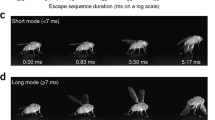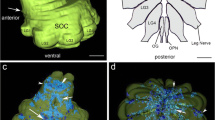Summary
-
1.
The uniquely identifiable pair of giant descending neurons ofMusca domestica andCalliphora erythrocephala are compared and described in relation to homologues inDrosophila.
-
2.
Cobalt coupling in the giant fibre system suggests that giant descending neurons receive inputs from antennal mechanosensory afferents and small-field visual interneurons.
-
3.
InMusca andCalliphora, terminals of giant descending neurons invade several discrete areas of neuropil. This is in contrast toDrosophila where homologous neurons have a relatively simple terminal.
-
4.
Despite differences in morphology, in all three species a homologous terminal region is cobalt-coupled to the largest of three motorneurons supplying the second leg's tergotrochanteral muscle.
-
5.
Sensory connections revealed anatomically were confirmed electrophysiologically by intracellular recording and dye-filling. Mechanosensory inputs from the ipsilateral antenna, and small field motion stimuli, or light ‘on’ and ‘off’ stimuli to the ipsilateral compound eyes, produce subthreshold activation in the giant descending neuron.
-
6.
As inDrosophila, light ‘on’ or ‘off’ stimuli presented to white-eyed mutants ofMusca andCalliphora elicit a spiking response in the giant descending neuron. In red-eyed flies, spikes could only be routinely induced by electrical stimulation across the head between the compound eyes or by releasing the cell from hyperpolarization.
-
7.
Double recordings from the giant (intracellular combined with lucifer or cobalt iontophoresis for cell identification) and from the tergotrochanteral motorneuron (extracellular in muscle) show that a spike in the giant neuron is usually sufficient to drive a spike in the tergotrochanteral muscle. Latencies are short, as reported inDrosophila. Releasing the giant from hyperpolarization can result in a motorneuron spike in the absence of a spike in the giant: this suggests the presence of an electrical synapse.
-
8.
Spiking in the tergotrochanteral muscle and the giant can occur independently of each other. Thus, this interneuron alone is neither necessary nor invariably sufficient for initiating ‘escape behaviour’ in the species studied. This is also corroborated by the structure of tergotrochanteral motorneurons whose extensive dendrites receive a variety of other inputs.
Similar content being viewed by others
Abbreviations
- DLM :
-
dorsal longitudinal indirect flight muscle
- GDN :
-
giant descending neuron
- PSI :
-
peripherally synapsing interneuron
- TTM :
-
tergotrochanteral muscle
- TTMm :
-
tergotrochanteral muscle motorneuron
References
Bacon JP, Altman JS (1977) A silver intensification method for cobalt-filled neurons in wholemount preparations. Brain Res 138:359–363
Bacon JP, Strausfeld NJ (1980) Non-random resolution of neuron arrangements. In: Strausfeld NJ, Miller TA (eds) Neuroanatomical techniques: Insect nervous system. Springer, Berlin Heidelberg New York
Baird DH, Hillis MS (1985) A mutantDrosophila motorneuron: anatomy and reduced HRP uptake. Soc Neurosci Abstr 11(2):921
Benshalom G, Dagan D (1985)Drosophila neural pathways. Genetic and electrophysiological analysis. J Comp Physiol A 156:13–23
Boeckh J, Kaissling K-E, Schneider D (1965) Insect olfactory receptors. Cold Spring Harb Symp Quant Biol 30:263–280
Bodian D (1942) Cytological aspects of synaptic function. Physiol Rev 22:146–169
Burkhardt D, Gewecke M (1965) Mechanoreception in Arthropoda: The chain from stimulus to behavioural pattern. Cold Spring Harb Symp Quant Biol 30:601–614
Clark G (1981) Neurological staining methods: Bodian's protargol method. In: Clark G (ed) Staining procedures used by the Biological Stain Commission, 3rd edn. Williams and Wilkins, Baltimore, pp 98–100
Coggshall JC (1978) Neurons associated with the dorsal longitudinal flight muscle ofDrosophila melanogaster. J Comp Neurol 177:707–720
Coggshall JC, Boschek CB, Buchner SM (1973) Preliminary investigations on a pair of giant fibres in the central nervous system of dipteran flies. Z Naturforsch 28:783–784
Desclin JC, Escubi J (1975) An additional silver impregnation method for demonstration of degenerating nerve cells and processes in the central nervous system. Brain Res 93:25–39
Gewecke M (1967) Die Wirkung von Luftströmung auf die Antennen und das Flugverhalten der blauen Schmeissfliege (Calliphora erythrocephala). Z Vergl Physiol 54:121–164
Gregory GE (1980) The Bodian protargol technique. In: Strausfeld NJ, Muller TA (eds) Neuroanatomical techniques; insect nervous system. Springer, Berlin Heidelberg New York
Hardie RC (1977) Flight initiation in the fly,Lucilia. Proc Aus Physiol Pharm Soc 8:95
Heisenberg M, Wolf R (1984) Vision inDrosophila. Genetics of Microbehaviour. Springer, Berlin Heidelberg New York Tokyo
Kaib M (1974) Die Fleisch und Blumenduftrezeptoren auf den Antennen der SchmeissfliegeCalliphora vicina. J Comp Physiol 95:105–121
King DG, Valentino KL (1983) On neuronal homology: a comparison of similar axons inMusca, Sarcophaga andDrosophila (Diptera: Schizophora). J Comp Neurol 219:1–9
King DG, Wyman RJ (1980) Anatomy of the giant fibre pathway inDrosophila. I. Three thoracic components of the pathway. J Neurocytol 9:753–770
Koto ML, Tanouye MA, Ferris A, Thomas JB, Wyman RJ (1981) The morphology of the cervical giant neuron ofDrosophila. Brain Res 221:213–217
Krasne FB, Wine JJ (1975) Extrinsic modulation of crayfish escape behaviour. J Exp Biol 63:433–450
Kupfermann I, Weiss KR (1978) The command neuron concept. Behav Brain Sci 1:3–39
Levine J, Tracy D (1973) Structure and function of the giant motorneuron ofDrosophila melanogaster. J Comp Physiol 87:213–235
Milde JJ (1986) Structure and response characteristics of ascending and descending interneurons in the flyCalliphora erythrocephala. Verh Dtsch Zool Ges (in press)
Milde JJ, Strausfeld NJ (1986) Visuo-motor pathways in arthropods: giant motion-sensitive neurons connect compound eyes directly to neck muscles in blowflies (Calliphora erythrocephala). Naturwissenschaften 73:138–145
Millonig G (1961) Advantages of a phosphate buffer for OsO4 solutions in fixation. J Appl Phys 32:1637
Mulloney B (1969) Interneurons in the central nervous system of flies and the start of flight. Z Vergl Physiol 64:243–253
Nachtigall W, Wilson DM (1968) Neuromuscular control of dipteran flight. J Exp Biol 47:77–97
O'Shea M, Adams M (1981) Pentapeptide (Proctolin: Arg-TyrLeu-Pro-Thr) associated with an identified neuron. Science 213:567–569
Power ME (1948) The thoracico-abdominal nervous system of an adult insect,Drosophila melanogaster. J Comp Neurol 88:347–409
Seyan HS, Bassemir UK, Strausfeld NJ (1983) Double marking for light and electron microscopy. In: Strausfeld NJ (ed) Functional neuroanatomy. Springer, Berlin Heidelberg New York Tokyo, pp 112–131
Spurr AR (1969) A low viscosity epoxyresin embedding medium for electronmicroscopy. J Ultrastruc Res 26:31–43
Stocker RF, Singh RN, Schorderet M, Siddiqi O (1983) Projection patterns of different types of antennal sensilla in the antennal glomeruli ofDrosophila melanogaster. Cell Tissue Res 232:237–248
Strausfeld NJ (1976) Atlas of an insect brain. Springer, Berlin Heidelberg New York
Strausfeld NJ, Bacon JP (1984) Multimodal convergence in the central nervous system of insects. In: Horn E (ed) Multimodal convergence in sensory systems. Fortschr Zool 28:47–76
Strausfeld NJ, Bassemir UK (1983) Cobalt-coupled neurons of a giant fibre system in Diptera. J Neurocytol 12:971–991
Strausfeld NJ, Bassemir UK (1985a) Lobula plate and ocellar interneurons converge onto a cluster of descending neurons leading to neck and leg motor neuropil inCalliphora erythrocephala. Cell Tissue Res 240:617–640
Strausfeld NJ, Bassemir UK (1985b) The organization of giant horizontal-motion-sensitive neurons and their synaptic relationships in the lateral deutocerebrum ofCalliphora andMusca. Cell Tissue Res 242:531–550
Strausfeld NJ, Obermayer M (1976) Resolution of intraneuronal and transsynaptic migration of cobalt in the insect visual and central nervous systems. J Comp Physiol 110:1–12
Strausfeld NJ, Seyan HS (1985) Convergence of visual, haltere and prosternal inputs at neck motor neurons. Cell Tissue Res 240:601–615
Strausfeld NJ, Singh RN (1980) Peripheral and central nervous system projections in normal and mutant (bithorax)Drosophila melanogaster. In: Siddiqi O, Babu P, Hall LM, Hall JC (eds) Development and neurobiology ofDrosophila. Plenum, New York, pp 267–291
Strausfeld NJ, Seyan HS, Wohlers D, Bacon JP (1983) Lucifer yellow histology. In: Strausfeld NJ (ed) Functional neuroanatomy. Springer, Berlin Heidelberg New York Tokyo, pp 132–155
Strausfeld NJ, Bassemir U, Singh RN, Bacon JP (1984) Organizational principles of outputs from dipteran brains. J Insect Physiol 30:73–93
Tanouye MA, Wyman RJ (1980) Motor outputs of the giant nerve fibre inDrosophila. J Neurophysiol 44:405–421
Thomas JB, Wyman RJ (1982) A mutation inDrosophila alters normal connectivity between two identified neurons. Nature 298:650–651
Thomas JB, Wyman RJ (1984) Mutations altering synaptic connectivity between identified neurons inDrosophila. J Neurosci 4:530–538
Venkatesh S, Singh RN (1984) Sensilla on the third antennal segment ofDrosophila melanogaster Meigen. Int J Insect Morphol Embryol 13:51–63
Williams JLD (1975) Anatomical studies of the insect central nervous system: A ground-plan of the midbrain and an introduction to the central complex in the locust,Schistocerca gregaria (Orthoptera). J Zool Lond 176:67–86
Wyman RJ, Thomas JB, Salkoff L, King DG (1984) TheDrosophila giant fibre system. In: Eaton R (ed) Neural mechanisms of startle behavior. Plenum, New York, pp 133–161
Wyman RJ, Thomas JB, Salkoff L, Costello W (1985) TheDrosophila thorax as a model system for neurogenetics. In: Selverston AL (ed) Model neural networks and behavior. Plenum, New York, pp 513–535
Author information
Authors and Affiliations
Additional information
We dedicate this paper to Prof. Dr. Franz Huber on the occasion of his 60th birthday
Rights and permissions
About this article
Cite this article
Bacon, J.P., Strausfeld, N.J. The dipteran ‘Giant fibre’ pathway: neurons and signals. J. Comp. Physiol. 158, 529–548 (1986). https://doi.org/10.1007/BF00603798
Accepted:
Issue Date:
DOI: https://doi.org/10.1007/BF00603798




